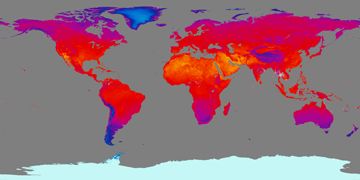
 |
||
|
|
||
| View other datasets |
|
|
| ||
 |
|||
| Coverage of this dataset spans March 2000 to July 2006. | |||
The animation features of the Earth Observatory are currently unavailable. We apologize for the inconvenience. To view the full temporal span of this dataset, please view the Night Land Temperature monthly holdings. | |||
 Product description: Land surface temperature is a good indicator of the energy balance at the Earth�s surface, and serves as an important indicator of the greenhouse effect. Land surface temperature is the sum of all the comings and goings of energy between the ground and the atmosphere, and as such, it can reveal quite a bit about surface conditions. That makes LST essential for a wide variety of climatic, hydrologic, ecological and biogeochemical studies. Land surface temperature can be used for evaluating water requirements of crops, for determining frost-damaged areas in orange groves, and for assessing the impact of climate change on the Arctic, an environment that will be particularly sensitive to rising global temperatures. The Moderate Resolution Imaging Spectroradiometer (MODIS) on NASA’s Terra and Aqua satellites take the temperature of every square kilometer of the Earth nearly every day, barring cloudy skies. MODIS senses the temperature of all natural and man-made land surfaces —everything from snow to deserts, from rooftops to treetops. The map above shows nighttime LST for the month indicated. (Daytime LST values are available as well.) Values range from 250 to 320 Kelvin (about -23 to 47 degrees Celsius, or -10 to 116 degrees Fahrenheit) in shades from light blue to yellow. Nighttime LST measurements have an interesting land-cover mapping application. Manmade surfaces such as concrete and asphalt that dominate cities typically absorb a lot more heat than the natural land cover that surrounds them. (Think about what it's like to drive out into the country on a hot day in the city.) Having soaked up heat all day long, cities stay warmer at night than their surrounding natural areas, and so they stand out as warm spots. This phenomenon has come to be called "the urban heat island effect," and scientists can study urban sprawl by using nighttime LST data like that from MODIS. Visualizations by Reto Stockli, Earth Observatory, based on data provided by the MODIS Science Team, NASA Goddard Space Flight Center
|
|
Subscribe to the Earth Observatory About the Earth Observatory Contact Us Privacy Policy and Important Notices Responsible NASA Official: Lorraine A. Remer Webmaster: Goran Halusa We're a part of the Science Mission Directorate |